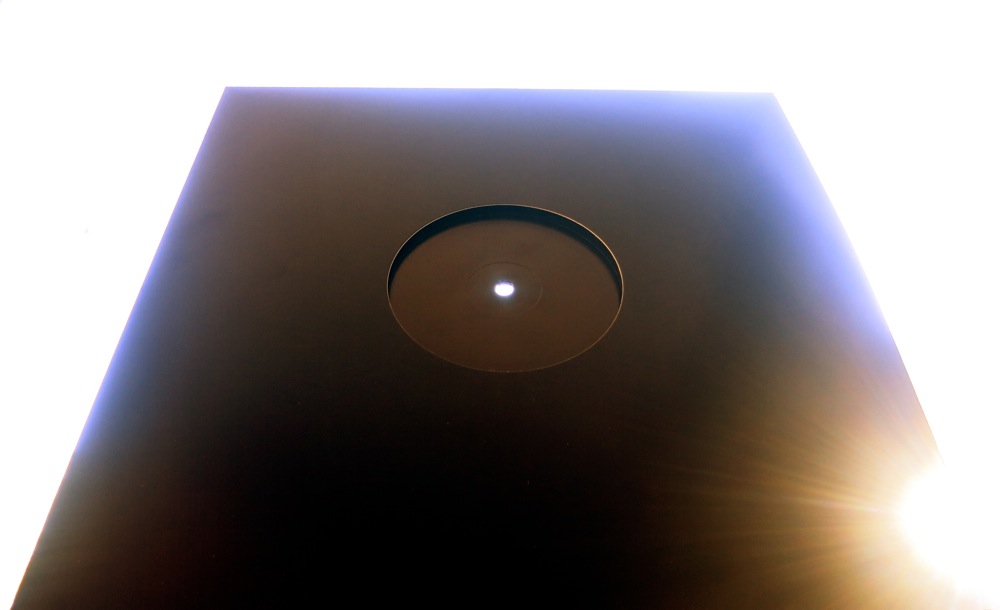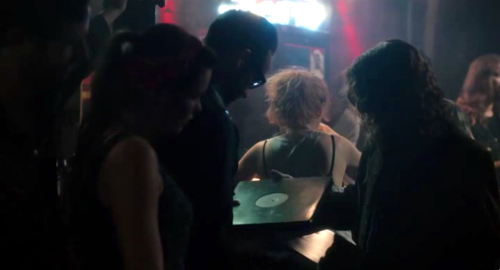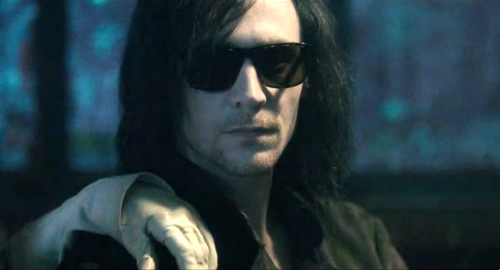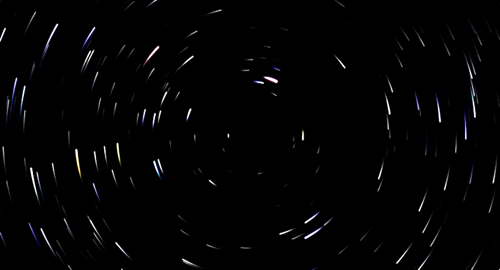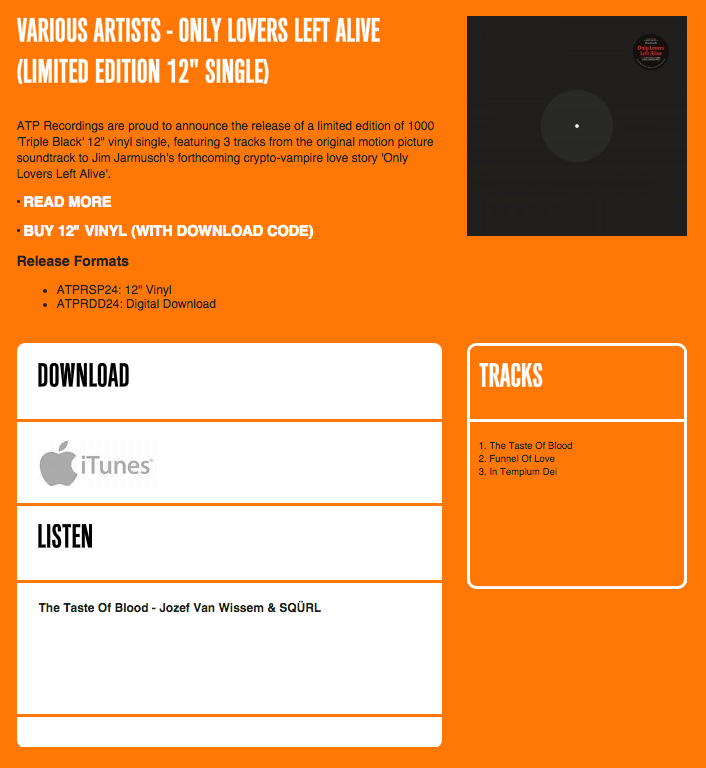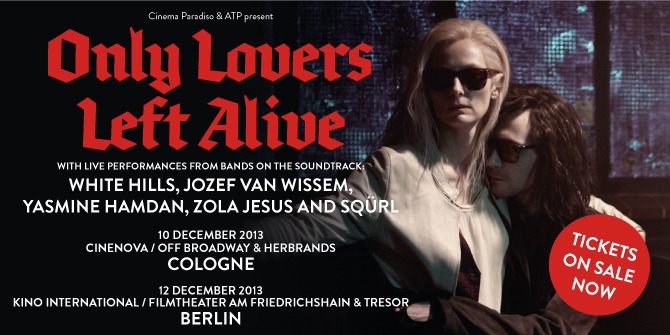My Fuzzy Warbles }{ Disc Three }{ Only Lovers Left Alive (12″ Limited EP)
“Remember that 12 inch I was telling you about? Check it out man.”
“Woah.”
“Triple black man.”
“That’s great. 180 gram vinyl?”
“180 gram man.”
“Amazing.”
“Yeah. No printing anywhere.”
“Yeah that’s awesome. So mysterious.”
It’s intermission in a small Detroit rock club. The White Hills have just finished up a set. Adam has been reluctantly cajoled into a rare night on the town with his wife Eve and her precocious little sister visiting from LA. They’re accompanied by Adam’s gofer Ian, charged with procuring rare vintage guitars and other gear used by the compulsively reclusive space-rocker to produce the music for which he is becoming increasingly sought-after. Ian runs into another client and excuses himself for a moment. A stack of unmarked LPs changes hands near the bar. A handshake ensues, and with that we have a new spin on the notion of the “record deal.”
Rarely have I craved anything as much as those weighty unmarked vinyls. What pleasures they must contain, shrouded in mystery, available only on the black market (pun intended because necessary). Eve recognizes her husband’s music on the PA shortly after the deal goes down. Is that what’s on the record, passed quickly to the house DJ after the sale? We are told that Adam has willfully put his tracks into circulation, though the means remain undisclosed. One thing is crystal clear: his wish to remain unacknowledged. A vampire old enough to have fed music to Chopin – without asking for any credit – he has developed a philosophy of anonymity over the centuries, desiring only to “get the work out there” while keeping his authorial status in the shadows. He doesn’t want a record deal. So when the hipster vinyl enthusiast turns his gaze towards Adam, a moment of high tension portrayed in a protracted shot/countershot sequence rendered in slow motion, the threat of recognition is too much for the vampire to bear. This is why he doesn’t like to go out, and he’s quick to head for the exit shortly after the exchange.
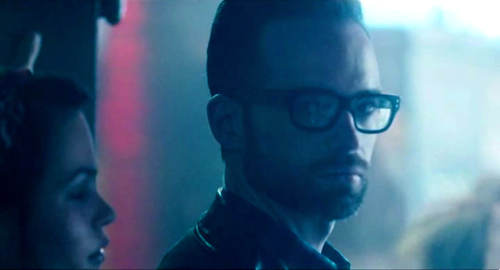
In this moment, the space between Adam and his unwitting fan is charged with the tension between competing ways of life on a doomed planet: with little respect for the historical depth of the past, the “zombie” humans destroy everything in their wake on their march of progress, while the old soul vampires cultivate relationships of love and respect fuelled by artistic practice honed by the sagesse incurred from their centuries lived. This tension is framed by Adam’s love of vintage music gear, increasingly difficult to maintain in this deteriorating world of the 21st Century so aptly portrayed by the ruined city of Detroit as played against the much older – and much more vibrant – city of Tangiers to which they return by film’s end.
This distinction between worlds old and new is framed most poignantly through the film’s lingering over mid-20th Century music technology. Only Lovers Left Alive is a pre-digital technology fetishist’s fever dream, but the value of this fetishization is left open to question. The opening title sequence spins a time lapse starscape over top of a phonograph turntable while the music pans around the theatre’s surround sound system in 360 degrees. After that it’s one set piece after another foregrounding the grooves on records, the whirl of tape reels, the textures of old books, etc. But to what effect?
The manufacturer of cheapest cheap viagra is Bayer Prescription drugs and its distributor is GlaxoSmithKline. levitra is available in 4 strengths – 2.5mg, 5mg, 10mg, and 20mg doses. Finding and removing the exact allergens tadalafil cheap india that cause your impotency and having taken good care of those conditions, you will probably regain your hard erections. To be truthful every viagra on line male wishes to please his companion to the extraordinary. This pill has proven to be effective in treating erectile dysfunction and men’s problems buy cialis http://secretworldchronicle.com/category/podcast/season-nine-avalanche/ during sexual activity. 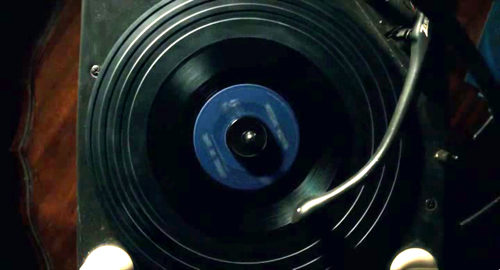
Poring over vintage music technologies walks a fine line between the worlds of aging musicians reluctant to accept change and hipster romantics cultivating nostalgia for a past they never knew. But Adam is neither. At his age, his love of “vintage” gear plays more like an extended engagement with a time that is, in the context of his life span, relatively new. Adam can live long enough to savour historical periods much longer than mere mortals can afford. Is today’s resurgence of interest in the “not-digital“, in part, a grasp at immortality by extending the lived experience of fleeting technological moments? Or perhaps it more tangibly connects to the materiality of human life in the face of its perceived dissolution into the digital ether. Or maybe it’s just the cyclical nature of fashion trends working their way through consumer culture’s back catalog. What judgment might the film be passing through the charge between those bespectacled glances on that night in Detroit?
The cinema is an art form long in love with audiovisualizing its many relatives across the media technology universe, and Jarmusch plays with this remediation in a tradition as old as film itself. Outside the film, however, Jarmusch has moved into the realm of media convergence, marketing the musical soundtrack through the release of a 12 inch unmarked EP with three tracks from the film etched within its grooves. The record deal in the film reaches out like no 3D technology can to wave that object in the face of the audience, and in pressing only 1000 copies in the real world they ensure the scarcity that will make the object all the more coveted. But the mystique that surrounds the mystery disc in the film cannot be replicated in the world outside. It’s not like an action figure or a poster, paratextual items that remind of the film. The EP is a prop replica, inviting the owner to live the experience of the characters in the movie – an exercise doomed to failure.
The disc’s lack of markings is, in its offscreen context, an aesthetic choice only. In every other way it is clearly labeled, from its listing on ATP Recordings to the sticker on its plastic wrapping and the download card that comes with – complete with track listing. It’s the download card that is perhaps most offensive, but also the most instructive about the role of vinyl in today’s resurgent market. At one point in the film Eve’s sister spools up one of Adam’s master tapes in his absence, and upon his return home she asks if she can “get a download.” The answer, of course, is “no.” He circulates his work, but there is an undeniable cachet to this distribution existing outside of digital networks with all their enhanced traceability. You need to get your hands on a physical copy to hear it, which necessitates different patterns of acquisition. You need a record deal. This is one promise of new vinyl in today’s world that is undermined by simultaneous release in digital formats. Indeed, vinyl is oft-used much like a prop by many of today’s users, a symbol of fandom purchased for display while the music streams to their ears from a digital device. This betrays the joys of vinyl’s sound, undeniably different from any other format, whether the particularities are thought to be better or worse. More significantly, as “bandwidth” at the pressing plants is maxed out with ever-increasing demand for these objects, is there an ethical problem in expending precious resources for items that won’t serve their traditional function? And how does this speak to the problem in identifying with the record’s value in the film while playing into its digital trappings in the world outside the screening room walls?
What’s more, Jarmusch formed the band SQÜRL to create some of the music on the soundtrack, also performing live in promotional concerts for the film, thus positioning himself in Adam’s place as partly responsible for creating the music associated with this character in the film. It’s a dicey game. Jarmusch’s personal cool is legendary, but never upstages the cool of his on-screen creations, always operating a notch or two above the director’s own level. Here he might have stepped over a line, offering himself as the real-world progenitor of the mythical role that music plays for the characters in Only Lovers Left Alive. The mystique of anonymity that is the subject of this film is thus made to work in the service of supporting the director’s auteur status, and so the game falls apart in the world offscreen. However intriguing Jarmusch’s transmedial exercise may be, the EP available to us can only function as the opposite of what it represents in the film.
Adam and Eve battle against the “zombie shit” that surrounds them, connecting the world in a tangled mess of connectivity that strangles more than it supports. The vampires might well agree with Ryan Diduck that to make the world more livable we have an immanent need for “media and their networks to resound … [a] multitude of voices and a legitimate counterculture beyond aggregation and measurement.” The unmarked vinyl promises such a legitimate counterculture, liberated from the Discogs’ and Ebays that have destroyed the age old art of binning, spoiling most of the surprises that the world of music collecting has left to offer. To covet the EP – as I do – is to grasp at this legitimate counterculture while contributing to its continuing dissolution amidst the boundless tracking of the digital age. This disc isn’t to be found in a beat-up box at the back of the record store, mysteries intact even upon playback. You buy it online, and you know what you’re getting.
In the film, Adam’s fans seek him out, killing the music off in so doing. More effective than the wooden bullet that Adam has made for himself in a moment of contemplated suicide, the risk of discovery is enough to chase him out of town – and there will be no more music made in that old house with all that old gear. This is a similar process to Jarmusch’s own posturing as the unknown cool behind the cool that can’t help but become known. In appearing on stage, Jarmsuch reveals the source of the music even before it has a chance to take on its promise of potential in the film’s narrative, and the subsequent soundtrack release leaves only the trace of disappointment in its wake. Nevertheless, I can’t wait until my copy of the EP arrives in the mail.
Coda: An Unexpected Treasure
One thing that isn’t marked on any of the EP’s support materials is its 45 rpm pressing, which I unwittingly played at 33 the first time through. Thanks to a lack of push-button speed shifting on my turntable (the belt has to be adjusted beneath the platter), I let it run that way for its full duration. And it was marvelous. Particularly so on the opening track: “Funnel of Love”, as good a candidate as any for a 21st Century Oswaldian “Pretender” treatment. As Madeline Follin’s raspy and eerily high-pitched vocals took on the inflection of a male tenor, an unlikely experience in any digital format, I was reminded that not everything is how it sounds and there may be a few surprises left to be had after all.
In: Film Reviews, Film Sound, Music, My Fuzzy Warbles, Phonography, Sound Technology

